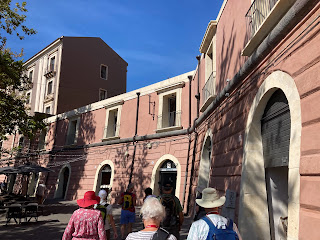After walking to a bus stop, we boarded a smaller, 21 passenger van for the hour or so trip north, up the coast, to the village of Taormina. We brought our Malta students here six years ago. It hasn't changed a bit.
Taormina is built on a steep hillside. It began as a Greek colony in the mid-4th century B.C.E. but was taken over by the Romans fairly early. The ancient claim to fame is a Greco-Roman theater that is still in use today.
It has a splendid view of Mt. Etna and the sea. However, it's certainly not the best preserved Greek theater we've ever seen. And the installation of modern, fiberglass seats does nothing at all for the preservation.
There is a smaller theater a few blocks away, probably older. It's not restored, but they don't charge admission and it's probably more interesting.
Our local guide, "Elfi," led a someone slow-paced tour peppered with some tired jokes that she probably uses often. We did gain some information about Taormina and about the history of the theater. But she spent a lot of time talking about the view, and about the various rock concerts that have been put on here recently. Yawn.
Once Elfi had finished, Flaminia took several of us to a pistachio shop. The proprietor spoke little English, so Flaminia translated his spiel about the family farm, the planting and harvesting of pistachios, etc. But our main focus was on the samples he provided! He had abundant trays of pistachio butter on bread, pistachio cannoli, and pistachio gelato, and we got a couple of each. We then bought and shared a pistachio granita (a kind of ice cream). It was all wonderful!
We walked the Main Street, revisited churches we've seen before, took in the ocean view, did a lot of people-watching, and even happened upon a restaurant we remembered eating in on our last visit.
This town is popular with a wealthier class of tourists, so the shops tend to be high end brands with high price tags. We weren't shopping.
Eventually, we sat down and ordered a beer near our meeting point. We continued our people-watching, and were joined by others in the group. Flaminia told us there was a problem with the bus being delayed, and that we would have an extra half hour to kill. So we walked side streets a bit more.
 |
| Large and intricate Nativity scene in one of the churches |
The bus was eventually an hour late, and the driver acted like nothing was out of the ordinary when he finally arrived. The drive back was uneventful.
At 5 p.m. we met for a "surprise experience" that Flaminia had arranged. We went out on the street and met a young man who specializes in real Sicilian folk music -- "music so old that Sicilians don't even know about it." He first played on a homemade shepherd's flute, then on a double flute, the design of which, he said, dates back to the Greeks.
Our musician continued playing a tambourine made from goat skin and tin cans. The technique for playing it was quite unusual -- much like an Irish bodhran, but using the hand rather than a stick. He also did an amazing job of playing a sort of primitive pair of castanets that were just two wooded slats, each about 8 inches long. Then he played a mandolin, a violin, and a small country accordion. I could have done without the accordion, but he played it well.
In a meeting room at the hotel we enjoyed our "farewell drink." This is an OAT tradition of toasting the trip and going around the room to say what we liked most. It was less painful than some.
Our farewell dinner was at another local seafood restaurant in the fish market area. The starter was a plate of huge steamed mussels. Next came a very large pasta with tuna sauce on top. Many assumed that was the main course, since it was so large, but it was followed by a slab of swordfish served with salad. An Italian ice was for dessert.
Our trip is concluded, and we head to the airport in the morning for what promises to be a very long day of travel back home.



















































